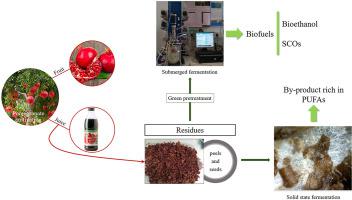Journal of Cleaner Production ( IF 11.1 ) Pub Date : 2021-09-27 , DOI: 10.1016/j.jclepro.2021.129193 Marianna Dourou 1 , Christina N. Economou 2 , Lida Aggeli 1, 2 , Miroslav Janák 1 , Gabriela Valdés 1 , Nefeli Elezi 1 , Dimitrios Kakavas 1 , Theodore Papageorgiou 1 , Alexandra Lianou 1 , Dimitrios V. Vayenas 2 , Milan Certik 3 , George Aggelis 1

|
Pomegranate residues (PRs), the solid residues comprising peels and seeds after juice extraction, are generated in abundance in Greece and contain a variety of carbon sources. Therefore, these residues can be regarded as a potential feedstock for chemical and biotechnological processes. The polysaccharides contained in PRs were extracted and hydrolyzed in a one-step process (not involving the use of chemical reagents), and the resulting broth was used as substrate in biotechnological applications, including ethanol and single cell oil (SCO) production. The yeasts Meyerozyma guilliermondii, Scheffersomyces coipomoensis, Sugiyamaella paludigena and especially Saccharomyces cerevisiae were able to efficiently convert reducing sugars derived from PRs into bioethanol. Ethanol production in static cultures (ensuring nearly anaerobic conditions) ranged from 3.6 to 12.5 g/L. In addition, the oleaginous yeasts Lipomyces lipofer and Yarrowia lipolytica as well as M. guilliermondii, S. coipomoensis and S. paludigena were tested for their ability to produce lipids suitable as feedstock for biodiesel production. Lipids were accumulated at concentrations up to 18% and were rich in palmitic and oleic acids. Finally, the oleaginous fungus Cunnichamella echinulata was cultivated on PR-based solid substrates for γ-linolenic acid (GLA) production. The fermented bio-products (i.e. fermented substrate plus fungal mycelia) contained up to 4.8 mg GLA/g of dry weight. Phenolic removal (up to 30%) was achieved by several of the above-mentioned microorganisms, including C. echinulata, L. lipofer, M. guilliermondii, S. paludigena and Y. lipolytica. In conclusion, the findings of this study demonstrate that PRs can be used as raw material for microbial growth, ethanol and SCO production, which is of economic and environmental importance.
中文翻译:

石榴残渣生物转化为生物燃料和生物活性脂质
石榴残渣 (PRs) 是提取果汁后由果皮和种子组成的固体残渣,在希腊大量产生,含有多种碳源。因此,这些残留物可被视为化学和生物技术过程的潜在原料。PRs 中含有的多糖通过一步法提取和水解(不涉及使用化学试剂),所得肉汤用作生物技术应用的底物,包括乙醇和单细胞油 (SCO) 生产。酵母菌Meyerozyma guilliermondii , Scheffersomyces coipomoensis , Sugiyamaella paludigena,尤其是Saccharomyces cerevisiae能够有效地将来自 PR 的还原糖转化为生物乙醇。静态培养中的乙醇产量(确保接近厌氧条件)范围为 3.6 至 12.5 g/L。此外,测试了产油酵母Lipomyces lipofer和Yarrowia lipolytica以及M. guilliermondii、S. coipomoensis和S. paludigena生产适合作为生物柴油生产原料的脂质的能力。脂质以高达 18% 的浓度积累并且富含棕榈酸和油酸。最后,产油真菌Cunnichamella echinulata在基于 PR 的固体基质上培养用于 γ-亚麻酸 (GLA) 生产。发酵生物产品(即发酵底物加真菌菌丝体)含有高达 4.8 mg GLA/g 干重。通过上述几种微生物实现酚类去除(高达 30%),包括C. echinulata、L. lipofer、M. guilliermondii、S. paludigena和Y. lipolytica。总之,这项研究的结果表明,PRs 可用作微生物生长、乙醇和 SCO 生产的原材料,这具有经济和环境重要性。


























 京公网安备 11010802027423号
京公网安备 11010802027423号